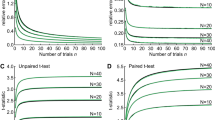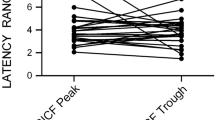Abstract
The purpose of this study was to determine the form of the relation between the mean amplitude and variance of motor-evoked potentials (MEP). To this end, single-pulse transcranial magnetic stimulation (TMS) was applied over the motor cortex of seventeen neurologically normal adult human subjects. The coil was positioned at a locus on the scalp that elicited an MEP in the first dorsal interosseous (FDI) at the lowest stimulus intensity. The subjects were instructed to maintain tonic activity in the FDI of 5 or 10% of the maximum voluntary contraction (MVC). The relation between MEP variance and amplitude was found to have an inverted parabolic shape, with maximal variance occurring near the half-maximal MEP amplitude. The coefficient of variation \(\text{CV}\) of MEPs decreased approximately as a rectangular hyperbolic function of MEP amplitude (i.e. ~ 1/MEP). A probabilistic model is proposed to explain the inverted parabolic relation between MEP variance and MEP amplitude, as well as the sigmoid shape of the MEP input–output relation (i.e. stimulus–response curve). The model is based on a description of α-motoneurons as binary threshold units, with unit thresholds distributed according to a positively skewed probability density function. The units are driven by noisy synaptic input currents having a Gaussian distribution. The model predicts an inverse parabolic relation between MEP variance and amplitude and a sigmoid input–output relation, as experimentally observed. Furthermore, increasing model motoneuron excitability by increasing the background synaptic drive increases MEP variability independently of MEP size, a surprising prediction. The model also explains the approximately rectangular hyperbolic relation between \(\text{CV}\) and MEP amplitude. The implications of these results for the interpretation of neurophysiological experiments and the statistical analysis of MEPs are discussed.









Similar content being viewed by others
Change history
11 October 2021
A Correction to this paper has been published: https://doi.org/10.1007/s00221-021-06240-3
References
Capaday C (1997) Neurophysiological methods for studies of the motor system in freely moving human subjects. J Neurosci Methods 74:201–218. https://doi.org/10.1016/s0165-0270(97)02250-4
Capaday C, Stein RB (1987) A method for simulating the reflex output of a motoneuron pool. J Neurosci Methods 21:91–104. https://doi.org/10.1016/0165-0270(87)90107-5
Capaday C, Lavoie BA, Barbeau H et al (1999) Studies on the corticospinal control of human walking. I. Responses to focal transcranial magnetic stimulation of the motor cortex. J Neurophysiol 81:129–139. https://doi.org/10.1152/jn.1999.81.1.129
Darling WG, Wolf SL, Butler AJ (2006) Variability of motor potentials evoked by transcranial magnetic stimulation depends on muscle activation. Exp Brain Res 174:376–385. https://doi.org/10.1007/s00221-006-0468-9
Devanne H, Lavoie BA, Capaday C (1997) Input-output properties and gain changes in the human corticospinal pathway. Exp Brain Res 114:329–338. https://doi.org/10.1007/pl00005641
Devanne H, Cohen LG, Kouchtir-Devanne N, Capaday C (2002) Integrated motor cortical control of task-related muscles during pointing in humans. J Neurophysiol 87:3006–3017. https://doi.org/10.1152/jn.2002.87.6.3006
Devore, J.L. (1987) Probability and Statistics for Engineering and the Sciences, 2nd edn. Brooks/Cole Publishing Company
Dideriksen JL, Negro F, Enoka RM, Farina D (2012) Motor unit recruitment strategies and muscle properties determine the influence of synaptic noise on force steadiness. J Neurophysiol 107:3357–3369. https://doi.org/10.1152/jn.00938.2011
Enoka RM (2008) Neuromechanics of human movement. Human Kinetics
Ferguson GA (1976) Statistical analysis in psychology and education, 4th edn. McGraw-HillInc, New York
Fuglevand AJ, Winter DA, Patla AE (1993) Models of recruitment and rate coding organization in motor-unit pools. J Neurophysiol 70:2470–2488. https://doi.org/10.1152/jn.1993.70.6.2470
Gustafsson B, Pinter MJ (1984) An investigation of threshold properties among cat spinal alpha-motoneurones. J Physiol 357:453–483. https://doi.org/10.1113/jphysiol.1984.sp015511
Hodgkin AL, Huxley AF (1952) A quantitative description of membrane current and its application to conduction and excitation in nerve. J Physiol 117:500–544. https://doi.org/10.1113/jphysiol.1952.sp004764
Hunt CC (1955) Monosynaptic reflex response of spinal motoneurons to graded afferent stimulation. J Gen Physiol 38:813–852. https://doi.org/10.1085/jgp.38.6.813
Julkunen P, Säisänen L, Hukkanen T et al (2012) Does second-scale intertrial interval affect motor evoked potentials induced by single-pulse transcranial magnetic stimulation? Brain Stimulat 5:526–532. https://doi.org/10.1016/j.brs.2011.07.006
Keenan KG, Farina D, Merletti R, Enoka RM (2006) Influence of motor unit properties on the size of the simulated evoked surface EMG potential. Exp Brain Res 169:37–49. https://doi.org/10.1007/s00221-005-0126-7
Kiers L, Cros D, Chiappa KH, Fang J (1993) Variability of motor potentials evoked by transcranial magnetic stimulation. Electroencephalogr Clin Neurophysiol 89:415–423. https://doi.org/10.1016/0168-5597(93)90115-6
Klein-Flügge MC, Nobbs D, Pitcher JB, Bestmann S (2013) Variability of human corticospinal excitability tracks the state of action preparation. J Neurosci off J Soc Neurosci 33:5564–5572. https://doi.org/10.1523/JNEUROSCI.2448-12.2013
Kouchtir-Devanne N, Capaday C, Cassim F et al (2012) Task-dependent changes of motor cortical network excitability during precision grip compared to isolated finger contraction. J Neurophysiol 107:1522–1529. https://doi.org/10.1152/jn.00786.2011
Lavoie BA, Cody FW, Capaday C (1995) Cortical control of human soleus muscle during volitional and postural activities studied using focal magnetic stimulation. Exp Brain Res 103:97–107. https://doi.org/10.1007/BF00241968
Pellicciari MC, Miniussi C, Ferrari C et al (2016) Ongoing cumulative effects of single TMS pulses on corticospinal excitability: an intra- and inter-block investigation. Clin Neurophysiol 127:621–628. https://doi.org/10.1016/j.clinph.2015.03.002
Press WH, Flannery BP, Teukolsky SA, Vetterling WT (1986) Numerical recipes: The art of scientific computing. Cambridge Univeristy Press, Cambridge
Rall W (1955a) Experimental monosynaptic input-output relations in the mammalian spinal cord. J Cell Comp Physiol 46:413–437. https://doi.org/10.1002/jcp.1030460303
Rall W (1955b) A statistical theory of monosynaptic input-output relations. J Cell Comp Physiol 46:373–411. https://doi.org/10.1002/jcp.1030460302
Rudomin P (1980) Information processing at synapses in the vertebrate spinal cord: presynapatic control of information transfer in monosynaptic pathways. In: Information processing in the nervous system. Raven Press, New York, pp 125–155
Rudomin P, Dutton H (1969) Effects of conditioning afferent volleys on variability of monosynaptic responses of extensor motoneurons. J Neurophysiol 32:140–157. https://doi.org/10.1152/jn.1969.32.2.140
Suckley JJ, Waters TJ, Tran M et al (2020) Randomising stimulus intensity improves the variability and reliability of the assessment of corticospinal excitability. J Neurosci Methods 342:108813. https://doi.org/10.1016/j.jneumeth.2020.108813
Trappenberg TP (2002) Fundamentals of computational neuroscience. Oxford University Press
Zucker RS, Kullmann DM, Schwarz TL (2004) Release of neurotransmiters. From molecules to networks. Elsevier Academic Press, Amsterdam, pp 197–235
Acknowledgements
This work was funded by the Canadian institutes of Health Research (CIHR) and in part by the Natural Sciences and Engineering Research Council of Canada (NSERC).
I thank Professors W.G. Darling and J.C. Rothwell for their comments and suggestions on a draft of the manuscript.
Author information
Authors and Affiliations
Corresponding author
Additional information
Communicated by Winston D. Byblow.
Publisher's Note
Springer Nature remains neutral with regard to jurisdictional claims in published maps and institutional affiliations.
Rights and permissions
About this article
Cite this article
Capaday, C. On the variability of motor-evoked potentials: experimental results and mathematical model. Exp Brain Res 239, 2979–2995 (2021). https://doi.org/10.1007/s00221-021-06169-7
Received:
Accepted:
Published:
Issue Date:
DOI: https://doi.org/10.1007/s00221-021-06169-7




